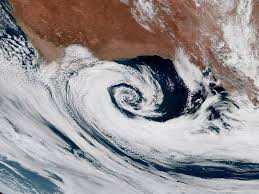Extratropical Cyclones – Geography Notes – For W.B.C.S. Examination.
এক্সট্রাট্রপিকাল ঘূর্ণিঝড় – ভূগোল নোট – WBCS পরীক্ষা।
Extratropical cyclone, also called wave cyclone or midlatitude cyclone, a type of storm system formed in middle or high latitudes, in regions of large horizontal temperature variations called frontal zones. Extratropical cyclones present a contrast to the more violent cyclones or hurricanes of the tropics, which form in regions of relatively uniform temperatures.Continue Reading Extratropical Cyclones – Geography Notes – For W.B.C.S. Examination.
According to the polar-front theory, extratropical cyclones develop when a wave forms on a frontal surface separating a warm air mass from a cold air mass. As the amplitude of the wave increases, the pressure at the centre of disturbance falls, eventually intensifying to the point at which a cyclonic circulation begins. The decay of such a system results when the cold air from the north in the Northern Hemisphere, or from the south in the Southern Hemisphere, on the western side of such a cyclone sweeps under all of the warm tropical air of the system so that the entire cyclone is composed of the cold air mass. This action is known as occlusion.
Typical weather sequences are associated with extratropical cyclones. Stations ahead of the approaching front side of the wave, called the warm front, normally experience increasingly thickening and lowering clouds, followed by precipitation, which normally persists until the centre of the cyclone passes by the station. If the station is located far to the south of the cyclone centre, then usually only a relatively short period of precipitation occurs during the passage of the back side of the wave, called the cold front. In high and middle latitudes a number of extratropical cyclones normally exist around the globe at any given time. These storms tend to form in preferred locations and follow typical paths, although exceptions to these typical patterns often occur. Compare tropical cyclone.
Storm is a generic term, popularly used to describe a large variety of atmospheric disturbances, ranging from ordinary rain showers and snowstorms to thunderstorms, wind and wind-related disturbances, such as gales, tornadoes, tropical cyclones, and sandstorms.
In meteorological terminology storm is restricted to a cyclone with a strong low pressure centre, strong winds, ranging from 103–117 kilometres per hour (64–73 miles per hour), accompanied by heavy precipitation, and at times, lightning and thunder.
Our own publications are available at our webstore (click here).
For Guidance of WBCS (Exe.) Etc. Preliminary , Main Exam and Interview, Study Mat, Mock Test, Guided by WBCS Gr A Officers , Online and Classroom, Call 9674493673, or mail us at – mailus@wbcsmadeeasy.in
Visit our you tube channel WBCSMadeEasy™ You tube Channel
Please subscribe here to get all future updates on this post/page/category/website



 Toll Free 1800 572 9282
Toll Free 1800 572 9282  mailus@wbcsmadeeasy.in
mailus@wbcsmadeeasy.in


















































































































